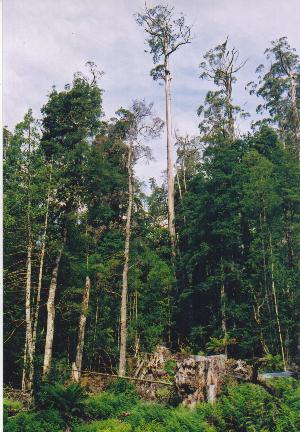Science News
Trees Can Only Grow So Tall
February 11, 2013
by Zuberoa Marcos

Just like people, leaves do not grow indefinitely. Once they reach a given size, they stop growing. But why? Researchers at Harvard and University of California Davis, published in the journal Physical Review Letters, have recently determined the cause.
After comparing 1,925 tree species, with leaves ranging in length from a few millimeters to over one meter, it turns out that the height of the tree is the determining factor. The reason lies in the plant’s circulatory system and the flow of energy-rich sugars along it.
All sugar in a tree is produced within its leaves. Through a network of tube-shaped cells called the phloem, it flows out to the trunk and the roots. But when a tree transports sugar through its leaves and trunk, resistance comes into play. The trunk’s resistance is directly proportional to the height, while the leaf’s resistance is inversely proportional to its length. This means that the taller the tree, the more energy is needed to transport the sugar around. For the leaf, the longer it gets, the less the resistance and the faster it can transport the sugar down to the trunk.
Scientists used these physical factors to create a mathematical model that relates the leaf size to a given tree size. As trees get taller, trunk resistance slows the flow. Increasing leaf size might partly offset this, but eventually the trunk resistance becomes so large and dominant that leaf size has little effect on the flow rate. Beyond a certain leaf size, there’s no advantage in making the leaves any bigger. For trees that are 100 meters tall, it doesn’t make sense to produce leaves longer than 20 cm. Meanwhile, if the leaf is too small, the sugar travels too slowly around the tree—setting the minimum leaf size.
The mathematical curves for maximum and minimum leaf size converge as trees grow taller. This could also be the reason why trees cannot grow beyond a certain height. The scientists’ formula predicts that at exactly 106 meters, close to the height of the tallest trees, these curves cross. According to the theory, if a tree were taller than this, no leaf size could meet its vascular requirements.
Some of the tallest trees are eucalyptus. They can grow up to 100-110 meters high with leaves between 10 and 30 cm.
Learn more about this research on You Tube: Trees are Freaking Awesome!
Zuberoa Marcos is a former biologist and current science writer based in Barcelona. She writes articles regularly for Science Today.
¿Por qué los árboles no pueden alcanzar más de 100 metros de alto?
Por Zuberoa Marcos
De igual manera que las personas, las hojas no crecen indefinidamente. Una vez que alcanzan un tamaño dado, éstas paran de desarrollarse. ¿Pero por qué? Recientemente, investigadores de Harvard y de la Universidad California Davis, han determinado la causa en un artículo publicado en la revista Physical Review Letters.
Tras comparar 1,925 especies de árboles, cuyas hojas oscilan desde unos pocos milímetros a más de un metro de longitud, han concluido que la altura del árbol es el factor clave. La explicación reside en el sistema circulatorio de la planta y en el flujo de azúcares a lo largo de él.
Todo el azúcar de un árbol se produce en sus hojas. A través de una red de tubos llamada floema, el azúcar transporta hacia el tronco y las raíces. Sin embargo, cuando un árbol transporta el azúcar a través de las hojas y del tronco, entra en juego la resistencia. En el tronco la resistencia es directamente proporcional a su altura, mientras que en la hoja es inversamente proporcional a su longitud. Esto significa que cuanto más alto sea el árbol, más energía se necesita para transportar el azúcar a través de él. En el caso de la hoja, cuanto más grande sea ésta menor es la resistencia y más rápido se puede transportar el azúcar.
Los científicos utilizaron estos factores para crear un modelo matemático que relaciona el tamaño de la hoja con la altura de un árbol en particular. Cuanto más crece un árbol, más lento es el flujo de azúcares a través de su tronco. El aumento de tamaño de la hoja podría compensar en parte este proceso, pero llegaría un punto en el que la resistencia del tronco sería tan grande y tan dominante que el tamaño de la hoja tendría poco o ningún efecto sobre la velocidad de transporte de los azúcares. Es decir, más allá de un cierto tamaño, producir hojas más grandes no proporciona ninguna ventaja. Para los árboles de 100 metros de altura, no tiene sentido producir hojas de más de 20 cm de longitud. Por otro lado, si la hoja es demasiado pequeña, el azúcar viaja muy lentamente a través del árbol, lo que determina el tamaño mínimo de la hoja.
Conforme los árboles crecen, las curvas matemáticas que determinan el tamaño de hoja máximo y mínimo convergen. Esto podría explicar por qué los árboles no pueden crecer más allá de cierta altura. La fórmula elaborada por los científicos predice que exactamente a 106 m, un valor cercano a la altura de los árboles más altos, ambas curvas se cruzan. De acuerdo a esta teoría, si un árbol supera esta altura no hay tamaño de hoja que pueda satisfacer sus necesidades vasculares.
Los eucaliptos son algunos de los árboles más altos. Pueden alcanzar hasta 100-110 metros y sus hojas miden entre 10 y 30 cm.
Zuberoa Marcos es bióloga retirada y actualmente trabaja como periodista científica desde Barcelona. Escribe de forma regular para Science Today.
Image: TTaylor/Wikipedia